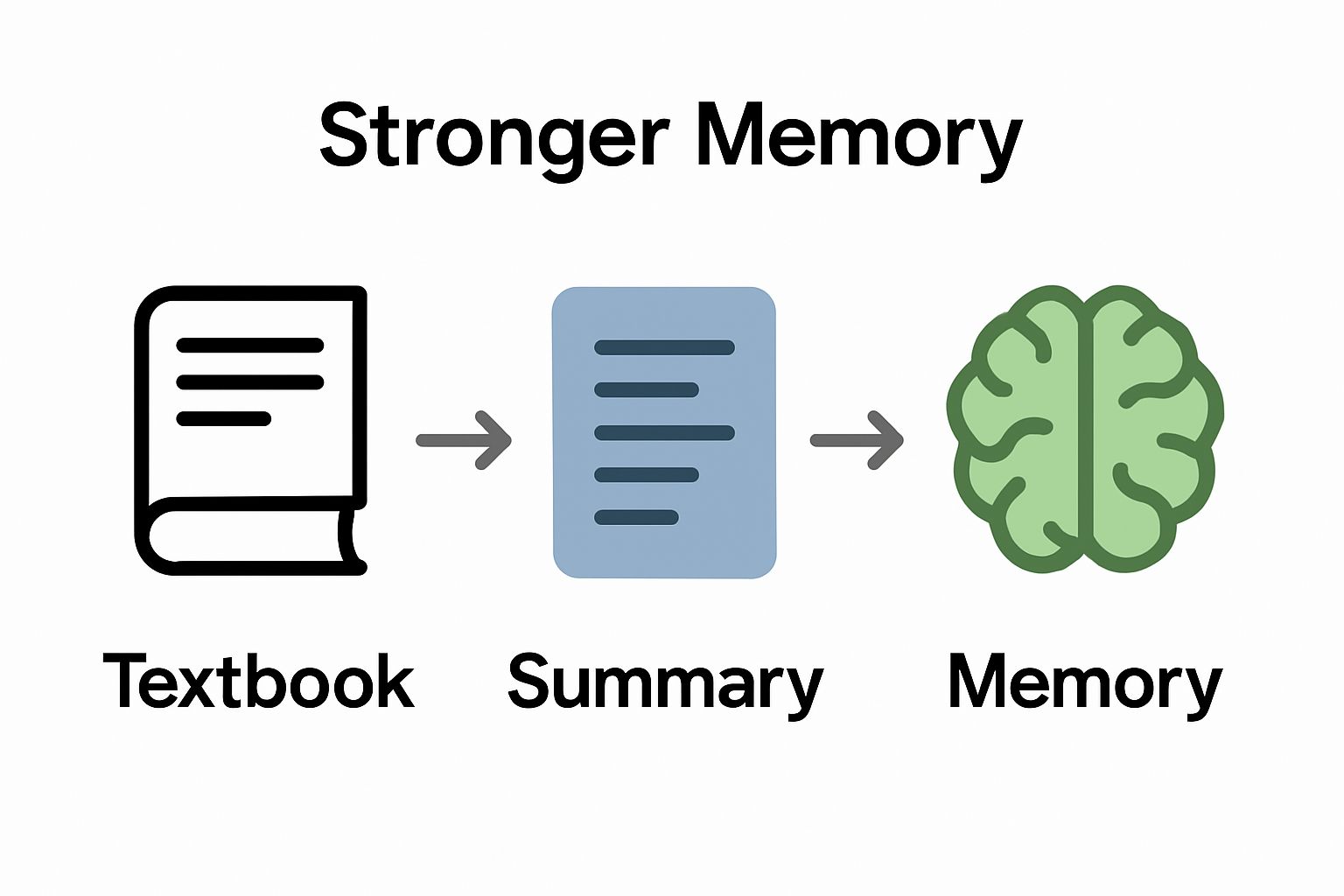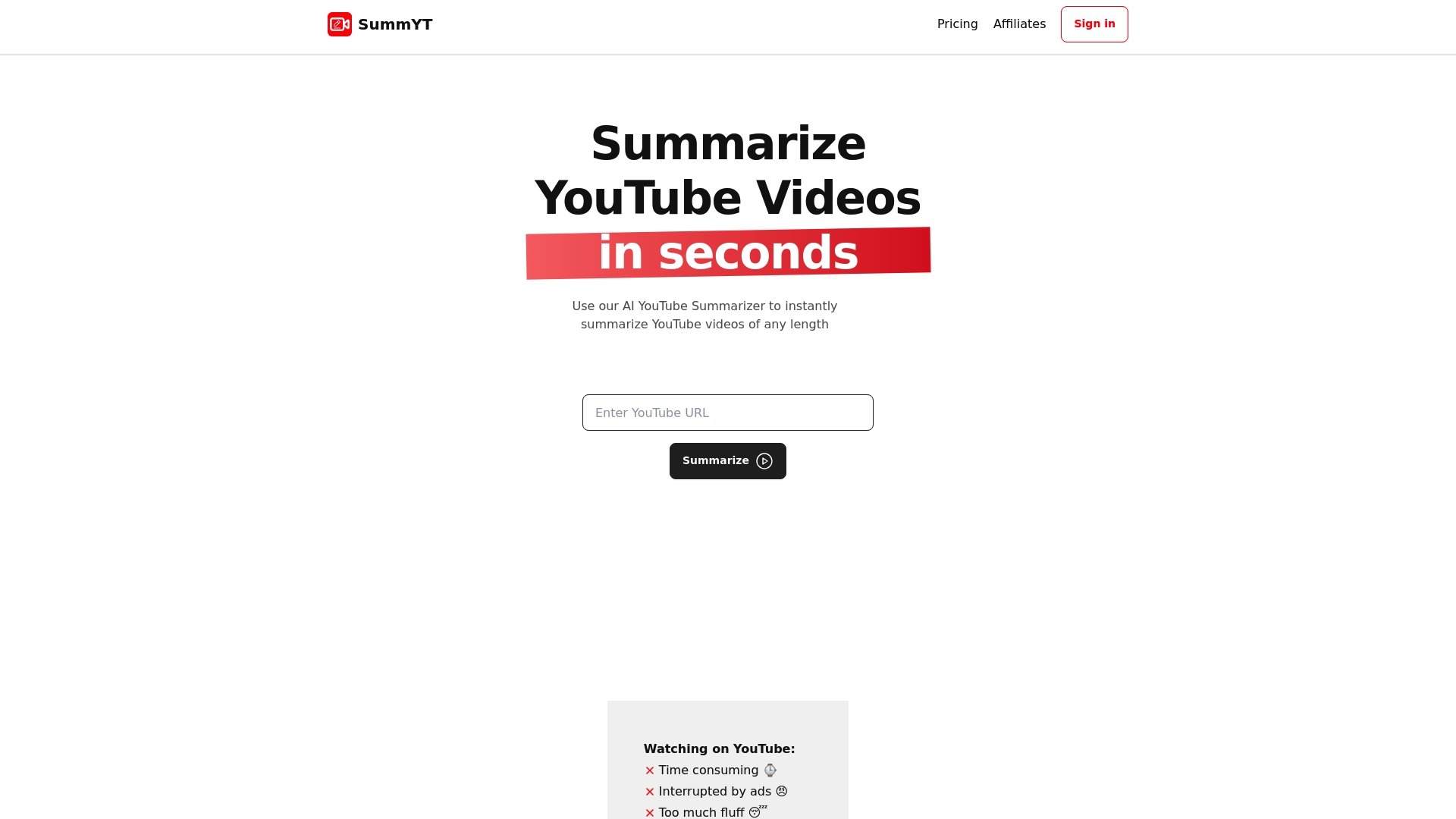Understanding How Summaries Aid Learning Effectively

Summaries are everywhere and they shape how we process information every day. Most people know that a good summary can save you time, but the real surprise is just how much brainpower it unlocks. Studies show that well-constructed summaries can improve comprehension rates by up to 40 percent compared to traditional, long-form content. What actually matters is not just saving time, but how summaries transform your memory and learning in ways you probably never expected.
To clarify how summaries impact learning, the table below compares key cognitive processes and benefits associated with engaging with summaries versus traditional long-form content.
| Method | Cognitive Processes Involved | Key Benefits |
|---|---|---|
| Summaries | Rapid identification of core concepts, reduced cognitive load, mental shortcut creation | Faster comprehension, improved retention, efficiency |
| Long-form Content | Requires sustained attention, processing of peripheral information, higher cognitive effort | In-depth understanding, exposure to details |
Table of Contents
- What Are Summaries And Their Role In Learning?
- The Importance Of Summaries In Comprehending Information
- How Summaries Enhance Memory Retention And Recall
- The Connection Between Summarization And Active Learning
- Practical Applications Of Summaries In Various Fields
Quick Summary
| Takeaway | Explanation |
|---|---|
| Summaries enhance cognitive processing. | Summaries help learners quickly grasp core concepts without overwhelming information. |
| Effective summaries improve comprehension rates. | Research shows that well-structured summaries can enhance understanding by up to 40%. |
| Summarization fosters active learning. | Creating summaries engages learners, transforming them into active participants in their education. |
| Summaries aid in memory retention. | They consolidate information, helping individuals better encode and retrieve essential knowledge. |
| Use summaries to bridge knowledge gaps. | Summaries facilitate communication across disciplines, making complex information more accessible to diverse audiences. |
What Are Summaries and Their Role in Learning?
Summaries represent condensed representations of original content that capture essential information, key ideas, and core messages while significantly reducing total reading or viewing time. In the context of learning, summaries function as powerful cognitive tools that transform complex information into digestible, manageable knowledge segments.
The Cognitive Function of Summaries
At their core, summaries facilitate efficient information processing by enabling learners to quickly understand main concepts without consuming excessive time. According to cognitive learning research from Stanford University, summaries help activate prior knowledge, enhance comprehension, and support knowledge retention by presenting information in a structured, concise format.
When learners encounter a summary, their brain performs several critical cognitive operations:
- Rapidly identify core concepts
- Connect new information with existing mental frameworks
- Reduce cognitive load associated with processing extensive material
- Create mental shortcuts for understanding complex topics
Transforming Learning through Condensed Knowledge
Summaries transcend mere information reduction. They represent strategic learning tools that enable individuals to quickly grasp complex subjects while maintaining critical contextual understanding. Research published in the Journal of Educational Psychology demonstrates that well-constructed summaries can improve comprehension rates by up to 40% compared to traditional long-form content consumption.
Learners can read more about video summary techniques for effective learning to unlock additional strategies for knowledge acquisition. By distilling intricate information into clear, focused narratives, summaries empower students, professionals, and lifelong learners to navigate increasingly complex informational landscapes with greater efficiency and understanding.
The Importance of Summaries in Comprehending Information
Understanding information requires strategic processing, and summaries serve as critical cognitive bridges that transform complex knowledge into accessible insights. By distilling extensive content into concentrated, meaningful representations, summaries enable learners to rapidly comprehend and retain essential information.
Cognitive Processing and Information Absorption
Summaries function as powerful mental frameworks that facilitate rapid information internalization. Research from educational psychology studies demonstrates that summarization teaches learners to critically distinguish between crucial and peripheral information, promoting deeper comprehension and selective attention.
When engaging with summaries, individuals experience several key cognitive benefits:
- Enhanced information filtration and prioritization
- Reduced cognitive load during learning
- Improved memory retention and recall
- Accelerated understanding of complex concepts
Strategic Knowledge Comprehension
Effective summaries go beyond simple content reduction. They represent sophisticated cognitive tools that help learners reconstruct and personalize information through active mental processing. By requiring individuals to synthesize and express concepts in their own words, summaries transform passive reading into an engaged learning experience.
Read more about why concise summaries matter in communication to explore how strategic information presentation can dramatically improve knowledge transfer. Summaries ultimately empower learners to navigate increasingly complex informational landscapes, turning overwhelming data streams into manageable, meaningful insights.
This table summarizes the main cognitive benefits that occur when learners use summaries, as described throughout the article.
| Cognitive Benefit | Description |
|---|---|
| Enhanced Information Filtration | Helps prioritize and focus on crucial information, filtering out less relevant details |
| Reduced Cognitive Load | Decreases mental effort required to process extensive material |
| Improved Memory Retention | Facilitates stronger and more accessible memory connections |
| Accelerated Comprehension | Enables faster understanding of complex topics |
| Active Knowledge Construction | Encourages learners to synthesize and rephrase information in their own words |
| Efficient Knowledge Transfer | Simplifies sharing and communicating key insights across different audiences and disciplines |
How Summaries Enhance Memory Retention and Recall
Memory retention represents a complex neurological process where summaries act as strategic cognitive catalysts, transforming information absorption and long-term knowledge preservation. By presenting information in concentrated, meaningful formats, summaries dramatically improve how our brains encode, store, and retrieve critical information.
Neurological Mechanisms of Summary Processing
The brain processes summaries through sophisticated cognitive mechanisms that optimize information storage. Neuroscience research from MIT reveals that condensed information triggers more efficient neural pathways, allowing learners to create stronger, more accessible memory connections.
When individuals engage with summaries, several neurological processes occur:

- Rapid activation of relevant neural networks
- Increased synaptic connections related to core concepts
- Simplified information encoding through strategic reduction
- Enhanced ability to link new information with existing knowledge frameworks
Cognitive Strategies for Memory Optimization
Summaries function as powerful memory consolidation tools that help learners transform passive information consumption into active knowledge integration. By requiring mental reconstruction and personal interpretation, summaries enable individuals to create personalized cognitive maps that significantly improve long-term recall.
Learn more about effective learning techniques with summaries to understand how strategic information processing can revolutionize your learning approach. Ultimately, summaries represent more than simple information shortcuts they are sophisticated cognitive instruments that empower learners to navigate complex knowledge landscapes with unprecedented efficiency and retention.
The Connection Between Summarization and Active Learning
Active learning represents a dynamic educational approach where learners engage directly with content, transforming passive information consumption into an interactive knowledge construction process. Summarization emerges as a critical technique that bridges theoretical understanding with practical cognitive engagement, enabling learners to become active participants in their own educational journey.
Cognitive Engagement through Summarization
Research in educational psychology reveals that summarization is not merely a passive recording technique, but a sophisticated cognitive processing strategy that demands high-level mental skills. When creating summaries, learners must:
- Critically analyze information
- Identify core concepts
- Synthesize complex ideas
- Reconstruct knowledge in personal frameworks
- Evaluate the relative importance of different information segments
Transforming Passive Learning into Active Knowledge Construction
Summarization transcends traditional learning methods by requiring learners to reconstruct and personalize information. This process transforms students from mere recipients of knowledge to active interpreters and creators of understanding. By compelling individuals to distill and express concepts in their own words, summaries foster deeper comprehension and more meaningful learning experiences.
Explore the role of summarizers for students to understand how these tools can revolutionize educational engagement. Ultimately, summarization represents a powerful bridge between passive information absorption and active, self-directed learning, empowering students to take control of their intellectual growth.
Practical Applications of Summaries in Various Fields
Summaries function as versatile tools that transcend traditional learning environments, offering strategic value across diverse professional domains. By distilling complex information into clear, concise representations, summaries enable efficient communication and knowledge transfer in multiple contexts.
Professional Knowledge Management
Medical professionals leverage summaries as critical communication tools that ensure precise information transmission during clinical handoffs and patient record reviews. In professional settings, summaries serve multiple critical functions:
- Accelerating information comprehension
- Reducing cognitive complexity
- Facilitating rapid decision making
- Minimizing potential misunderstandings
- Supporting cross disciplinary collaboration
Interdisciplinary Communication Strategies
Summaries represent powerful knowledge translation mechanisms that bridge intellectual gaps between specialized fields. Researchers, journalists, consultants, and academics rely on summaries to communicate nuanced concepts across different expertise levels, transforming intricate technical information into accessible insights.
Learn more about the advantages of AI summaries to understand how technological innovations are revolutionizing information processing. Ultimately, summaries emerge as essential cognitive instruments that enable professionals to navigate increasingly complex informational landscapes with unprecedented efficiency and clarity.

Turn Summaries Into Your Learning Superpower With SummYT
Are you overwhelmed by endless YouTube videos full of information yet struggle to grasp the key points efficiently? The article “Understanding How Summaries Aid Learning Effectively” shows how thoughtful summaries unlock rapid comprehension, memory retention, and active learning. But with video content, time and attention are precious. Missing the essentials means wasted hours and less mastery.

Experience the next level of effective learning today. Let SummYT handle the work of creating clear, concise summaries from any YouTube video, so you get right to core concepts. Whether you are a student, a professional, or committed to lifelong learning, SummYT helps you remove distractions, reduce cognitive overload, and turn even the longest videos into insightful, manageable knowledge chunks. Ready to learn faster and remember more? Visit SummYT now and start transforming your video learning routine.
Frequently Asked Questions
What are the cognitive benefits of using summaries in learning?
Summaries help learners rapidly identify core concepts, reduce cognitive load, and create mental shortcuts for understanding complex topics, enhancing overall comprehension and retention.
How do summaries help improve memory retention?
Summaries act as cognitive catalysts that optimize information storage in the brain, enabling better encoding and retrieval of critical information through condensed and meaningful formats.
What role do summaries play in active learning?
Summarization transforms passive learning into active engagement by requiring learners to analyze, synthesize, and personalize information, promoting deeper comprehension and self-directed learning.
In what professional fields are summaries particularly useful?
Summaries are valuable across various fields, including healthcare for clinical communication, and in research and journalism for translating complex information into accessible insights.




